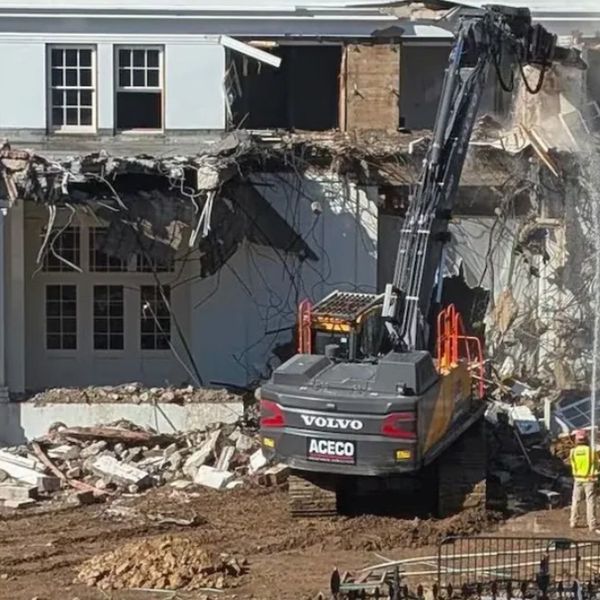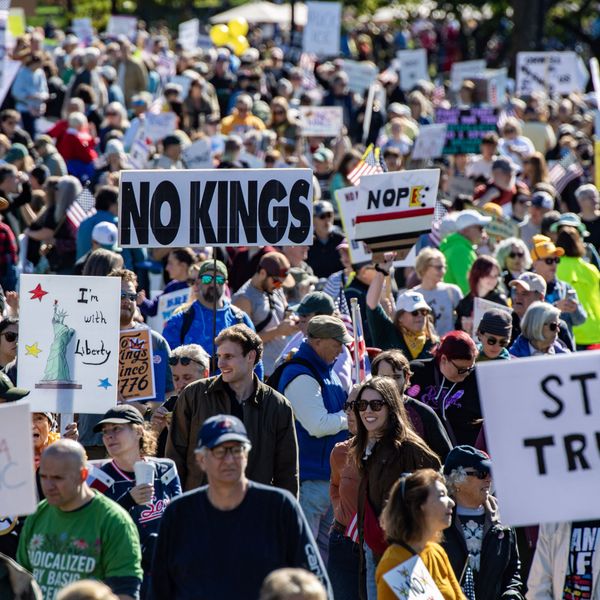"Don't cry here," an 86-year-old Okinawan grandmother I had never met before told me. She stood next to me and took my hand. I had been visiting my family in Okinawa with my four children early in August and had traveled to Henoko, in the northeastern region of our main island, to join the protest against the U.S. military's relocation of the U.S. Marine Corps Air Station from Futenma, located in the center of an urban district, to Camp Schwab, in a more remote coastal region. My teenage daughter, Kaiya, and I had spent the day with a crowd of elders holding protest signs in front of the gates of Camp Schwab. Rows and rows of more than 400 trucks hauling large rocks passed by, ready to outline an ocean area for the new base, equivalent to the size of 383 football fields. Our beautiful, tropical ecosystem with all of its internationally proclaimed and protected biodiversity was to soon be crushed, destroying coral and marine life. This, despite the overwhelming opposition of Indigenous island people. I began to cry as I held up my protest sign.
"Grandma is going to cry when I get home tonight so I will be crying with you," she said squeezing my hand. "Here, we fight together." We watched as trucks flooded through the gate of the military base where Japanese police had pushed us away moments before. With tears in her eyes she said, "It wouldn't be strange if we all jumped in front of every one of those trucks, because this is our ocean. This is our island."
If built, there will be no reversing the damage to our ocean, our coral, and our sea life.
Four months have passed since I joined the Okinawan elders back home and so many have continued to hold sit-ins every week -- for some, every day -- despite being forcefully removed by Japanese riot police. Meanwhile, the concrete blocks and metal bars have been dropped into the ocean on top of the coral to outline where the base will be constructed. Governor Takeshi Onaga, who had succeeded in halting the base construction, died from cancer in August and the Okinawan people elected a new governor, Denny Tamaki, by an overwhelming majority -- based on his promise that he would stop the Henoko destruction. More than 75,000 Okinawans showed up in an island-wide protest during typhoon weather to show the world how strongly we oppose this base construction. Yet, the Japanese central government announced that on December 13th (UST) -- this Thursday -- they will resume the landfill with sand and concrete. Authorities argued that building a new Henoko base is necessary in order to maintain the U.S.-Japan security alliance; and U.S. government leaders touted the base's location for regional security.
But if built, there will be no reversing the damage to our ocean, our coral, and our sea life.
The Henoko base construction is framed by the history of colonization and racism against Okinawans, as well as by our ongoing resistance as we attempt to end the long era of U.S. occupation. Okinawa was once an independent kingdom; it was colonized by Japan in the 17th century and during World War II became the victim of the bloodiest battle in the history of the Pacific, where more than a third of our people were killed within three months, including members of my family. Ninety-two percent of Okinawans were left homeless.
Frequent violent crimes against women and children by U.S. military personnel regularly bring out hundreds of thousands of protesters to demand justice and humanity and the complete removal of U.S. bases.
The United States then took the land from the Okinawan people, created military bases, and imposed a new constitution on Japan that took away Japan's right to have an offensive military. Henceforth, the U.S. military would "protect" Japan with bases throughout Japanese territory. However, three-quarters of all U.S. bases on Japanese territory are on Okinawa, even though Okinawa makes up only 0.6 percent of the total landmass that Japan controls. Okinawa's main island alone is only 62 miles long, and an average of one mile wide. It is here that 73 years of U.S. base occupation has created environmental destruction, air pollution and noise pollution, and exposed survivors and families to the sights and sounds of war. Frequent violent crimes against women and children by U.S. military personnel regularly bring out hundreds of thousands of protesters to demand justice and humanity and the complete removal of U.S. bases.
And the occupation continues. Now, the Japanese central government enforces the construction of yet another base -- this one in the ocean itself, in the Henoko region of Okinawa. This new chapter in the ongoing invasion of Okinawa disregards the sovereignty, self-determination and human rights guaranteed by United Nations resolutions. The Okinawan people have voted overwhelming to oppose the base construction -- for more than 20 years, since the base was first proposed.
The Okinawan people have voted overwhelming to oppose the base construction -- for more than 20 years, since the base was first proposed.
The marine habitat of Henoko is second only to the Great Barrier Reef in biodiversity. More than 5,300 species live in Oura Bay, including 262 endangered species like the dolphin-like dugong and sea turtles. Already this week, the Ryukyu Shimpo reported that two of the closely monitored dugong are missing, with predictions that the noise level of the construction has already hindered their ability to graze on seaweed beds.
For me, the Henoko struggle is about honoring my people's existence and our right to protect our native land. I draw inspiration from the Australian students' protest to stop the Adani coal company from building coal mines in Queensland, and from the Kanaka Maoli people's movement to block the destruction of Mauna Kea in Hawai'i for an 18-story telescope. Okinawa is my home, my ancestral home. To have it destroyed is unfathomable.
The United States has more than 800 military bases in more than 70 countries across the globe. And each of these places are, or were, people's homes -- just like my people's in Okinawa.
Of course, what's happening in Okinawa is not an isolated outrage. The United States has more than 800 military bases in more than 70 countries across the globe. And each of these places are, or were, people's homes -- just like my people's in Okinawa. The devastation of Henoko is part of a larger, world-wide U.S. imperialist footprint. What happens in Okinawa matters for Indigenous peoples everywhere. What happens in Okinawa matters for sovereignty fights everywhere. What happens in Okinawa matters for fragile ecosystems everywhere.
As I write, I'm receiving reports from Okinawa announcing the arrival of more ships carrying sand and concrete ready to pour the outline of the 205 hectare area. With only four days left before this destruction of irreplaceable biodiversity, a fellow Okinawan American activist and I created a hashtag campaign to demand the stopping of the base construction in Henoko: #standwithokinawa.
Please post your solidarity message, demanding your representatives take part in protecting Henoko, and connect with organizations and allies to help us fight for our rights as Okinawan people. In addition, organize international solidarity efforts to amplify the urgency of stopping the base construction. Sign the petition to President Trump demanding that the United States stop the landfill of Henoko at https://petitions.whitehouse.gov/petition/stop-landfill-henoko-oura-bay-until-referendum-can-be-held-okinawa.
In the words of one auntie at the sit-in this past summer, "It hasn't been the governments or politicians that have stopped this heliport construction over the last five years. It has been ordinary people; volunteers, the elderly and people who just care about Okinawa. And that's going to be who changes this now. Ordinary people, many, many of us together." We need the world with us. Stand with Okinawa.


